Looking to learn about the gorgeous blue-tongued skinks? You’re in the right place. Here, we’ll cover everything you want to know: diet, habitat, 8 different species, and more!
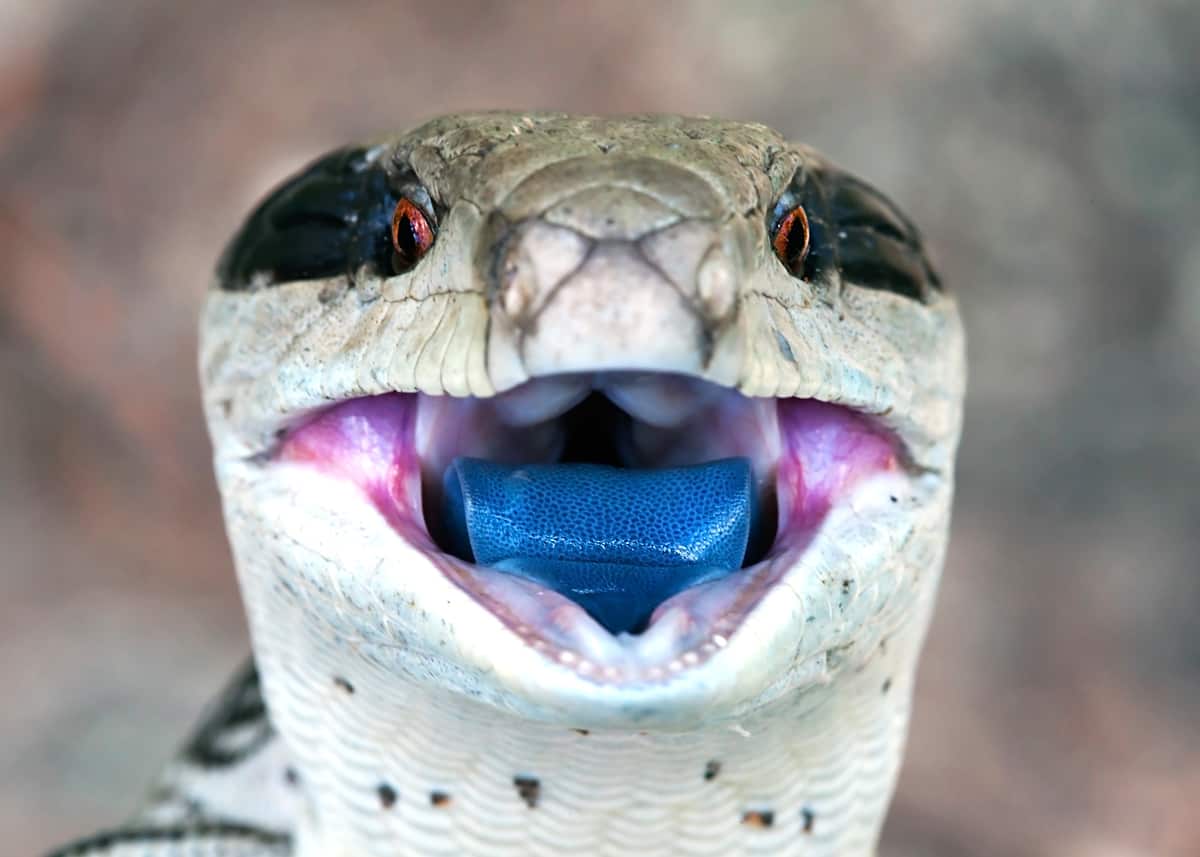
Blue-tongued skinks are colorful little lizards that are full of quirks. Not only do they have long, crayon-colored tongues, but they can also hatch eggs inside of their bodies and amputate their own tails in an emergency. That’s just the beginning of their craziness, too!
Are you ready to learn more about blue-tongued skinks? Let’s start with an overview of the species.
Jump to blue-tongued skink facts
Ultimate Guide to Blue-Tongued Skinks – 8 Species
1. Adelaide pygmy blue-tongued skink
- Latin name: Tiliqua adelaidensis
- Where they are found: South Australia
- Size: 9 – 15 centimeters
- Diet: Insects, flowers, fruits
What’s unique about the Adelaide pygmy blue-tongued skink?
Also known as the “pygmy bluetongue,” this lizard was thought to be completely extinct until it was rediscovered in the early 1990s.
Conservationists have been working hard to bring its numbers back up, and a successful breeding program was established a few years ago. It’s still critically endangered, but its population size is estimated at 5,000 – 7,000.
Fun fact: Its name is actually a mistake. It was thought to originate in the city of Adelaide, but further studies have proved that untrue. The name just stuck.
What does the Adelaide pygmy blue-tongued skink look like?
The Adelaide pygmy blue-tongued skink has a mottled appearance with scales that are a mix of brown, black, bronze, grey and white. It’s the smallest skink species; it measures just 9 – 15 centimeters long on average.
2. Australian blue-tongued skink
- Latin name: Tiliqua scincoides scincoides, Tiliqua scincoides intermedia, Tiliqua scincoides chimaera
- Where they are found: Australia, Indonesia
- Size: 40 centimeters
- Diet: Insects, flowers, reeds, berries
What’s unique about the Australian blue-tongued skink?
The Australian blue-tongued skink has three different sub-species:
- Tiliqua scincoides scincoides (found in southern and eastern Australia)
- Tiliqua scincoides intermedia (found in northern Australia)
- Tiliqua scincoides chimaera (found in Indonesia)
Due to their range, the Australian bluetongues are one of the most common blue-tongued skinks. They’ve even been known to hang out in residential areas of Sydney!
Homeowners usually welcome them because they eat garden pests like slugs and snails.
What does the Australian blue-tongued skink look like?
The Australian blue-tongued skink can come in a variety of colors. Its most basic form is a mix of brown, orange, black and gray. But it’s most startling form is a light blue that offsets its bright cobalt tongue.
3. Blotched blue-tongued skink
- Latin name: Tiliqua nigrolutea
- Where they are found: Australia, Tasmania
- Size: 35 – 50 centimeters
- Diet: Snails, rodents, flowers, fruits, carrion
What’s unique about the blotched blue-tongued skink?
The blotched blue-tongued skink is one of the easier species to identify. It’s rarely a solid color, so you can recognize it right away by its splotchy scales. It’s also one of the largest of the blue-tongued skinks.
What does the blotched blue-tongued skink look like?
As you might have guessed from the name, the blotched blue-tongued skink has a mottled appearance.
It’s usually light gray or cream with darker spots, but its color palette can also reverse into a dark black body with pale gray or orange spots.
4. Centralian blue-tongued skink
- Latin name: Tiliqua multifasciata
- Where they are found: New South Wales
- Size: 30 – 45 centimeters
- Diet: Seeds, insects, carrion, livestock dung
What’s unique about the Centralian blue-tongued skink?
In addition to its bright yellow-orange color, the Centralian blue-tongued skink can be distinguished from its cousins by its size and shape.
It’s one of the largest skinks out there, and it can carry a lot of weight in its abdomen, so it’s fairly easy to tell when you’re looking at a Centralian bluetongue as opposed to an Australian or Indonesian one.
What does the Centralian blue-tongued skink look like?
The Centralian blue-tongued skink has a white-ish body with 11 – 13 orange bands wrapping around it. Two black bands run down either side of its head, and its round, robust abdomen can make it appear almost fat. It’s definitely one of the odder critters in the bluetongue family!
5. Indonesian blue-tongued skink
- Latin name: Tiliqua gigas gigas, Tiliqua gigas keyensis, Tiliqua gigas evanescens
- Where they are found: Indonesia, New Guinea
- Size: 20 – 30 centimeters (body), 50 – 60 centimeters (total)
- Diet: Fruits, flowers, small insects
What’s unique about the Indonesian blue-tongued skink?
There are three sub-species of the Indonesian blue-tongued skink:
- Tiliqua gigas gigas, also known as the Indonesian blue-tongued skink
- Tiliqua gigas keyensis, also known as the Kei island blue-tongued skink
- Tiliqua gigas evanescens, also known as the Merauke blue-tongued skink
They’re scattered around different parts of Indonesia and New Guinea, so if you’re traveling there, the specific type of blue-tongue that you’ll see will depend on your exact vacation spot.
What does the Indonesian blue-tongued skink look like?
Though it measures an impressive 50 – 60 centimeters long, the Indonesian blue-tongued skink is mostly tail. This single appendage can make up more than half of its length!
It’s also distinctive thanks to the black discoloration along its yellow-and-orange body. It might be banded, or it might be splotchy, but it always ends in solid-colored black legs.
6. Irian Jaya blue-tongued skink
- Latin name: Tiliqua sp.
- Where they are found: New Guinea
- Size: 50 – 60 centimeters
- Diet: Unknown, but probably insects and flowers
What’s unique about the Irian Jaya blue-tongued skink?
The Irian Jaya blue-tongued skink is one of the most mysterious breeds of blue-tongue. It hasn’t been scientifically classified, so its Latin name simply translates to “lizard species,” and there are some people who argue that it shouldn’t be a separate breed at all.
It has features of many different types of blue-tongue, so it’s possible that it’s a naturally-occurring hybrid breed rather than a “true” blue-tongued skink.
What does the Irian Jaya blue-tongued skink look like?
The Irian Jaya blue-tongued skink comes in a myriad of colors. Brown is the most common, but you’ll also see it with black, gold, cream, peach and even red scales.
It tends to be on the larger side, but there are some specimens that can be more diminutive.
7. Shingleback
- Latin name: Tiliqua rugosa
- Where they are found: Eastern and Western Australia
- Size: 25 – 30 centimeters
- Diet: Insects, flowers, carrion, dung
What’s unique about the shingleback skink?
Shinglebacks are named for their rugged appearance. They have tough, textured scales that function like body armor against predators.
They’re hefty creatures that store fat reserves in their tails for the winter. For this reason, they can’t shed their tails like other skinks.
There are four total sub-species of shinglebacks:
- Tiliqua rugosa rugosa (found in Western Australia)
- Tiliqua rugosa asper (found in eastern Australia)
- Tiliqua rugosa konowi (found on Rottnest Island)
- Tiliqua rugosa palarra (found in Shark Bay)
What does the shingleback skink look like?
The shingleback has a large, fat body with pointed scales. It can come in a variety of colors, but it’s usually dark brown or black.
Its stumpy tail resembles its head, so it’s sometimes called the “two-headed skink.”
8. Western blue-tongued skink
- Latin name: Tiliqua occipitalis
- Where they are found: Australia, New Guinea, Indonesia
- Size: 40 – 45 centimeters
- Diet: Insects, spiders, snails
What’s unique about the Western blue-tongued skink?
The Western blue-tongued skink has one of the widest ranges of the species, but it’s still vulnerable to extinction. It’s considered “threatened” in New South Wales and “near-threatened” in Victoria.
It’s a slow, gentle creature, so it makes a popular pet. But people are being encouraged to be careful with their Western blue-tongues. The future of the species could depend on it.
What does the Western blue-tongued skink look like?
The Western blue-tongued skink has a white or cream-colored body with wide brown bands.
There are usually distinctive black markings around the eyes. It has short legs and a big body, so it doesn’t move very fast.
21 Blue-Tongued Skink Facts
1. What does the blue-tongued skink look like?
While they have the same general morphology, the blue-tongue skink comes in an entire rainbow of colors. Here’s a breakdown:
- Adelaide pygmy blue-tongued skink – small body with brown, black, bronze, grey and white scales
- Australian blue-tongued skink – different colors, but its most famous is light blue
- Blotched blue-tongued skink light body with dark blotches or dark body with light blotches
- Centralian blue-tongued skink – white body with orange or yellow bands
- Indonesian blue-tongued skink – multiple colors, small body, long tail that makes up most of its size
- Irian Jaya blue-tongued skink – multiple colors as a potential hybrid species
- Shingleback – rough scales, wide tail that resembles another head
- Western blue-tongued skink – white or cream-colored body with brown bands
2. How big is a blue-tongued skink?
With the exception of the pygmy species, most bluetongues are around 30 – 50 centimeters long.
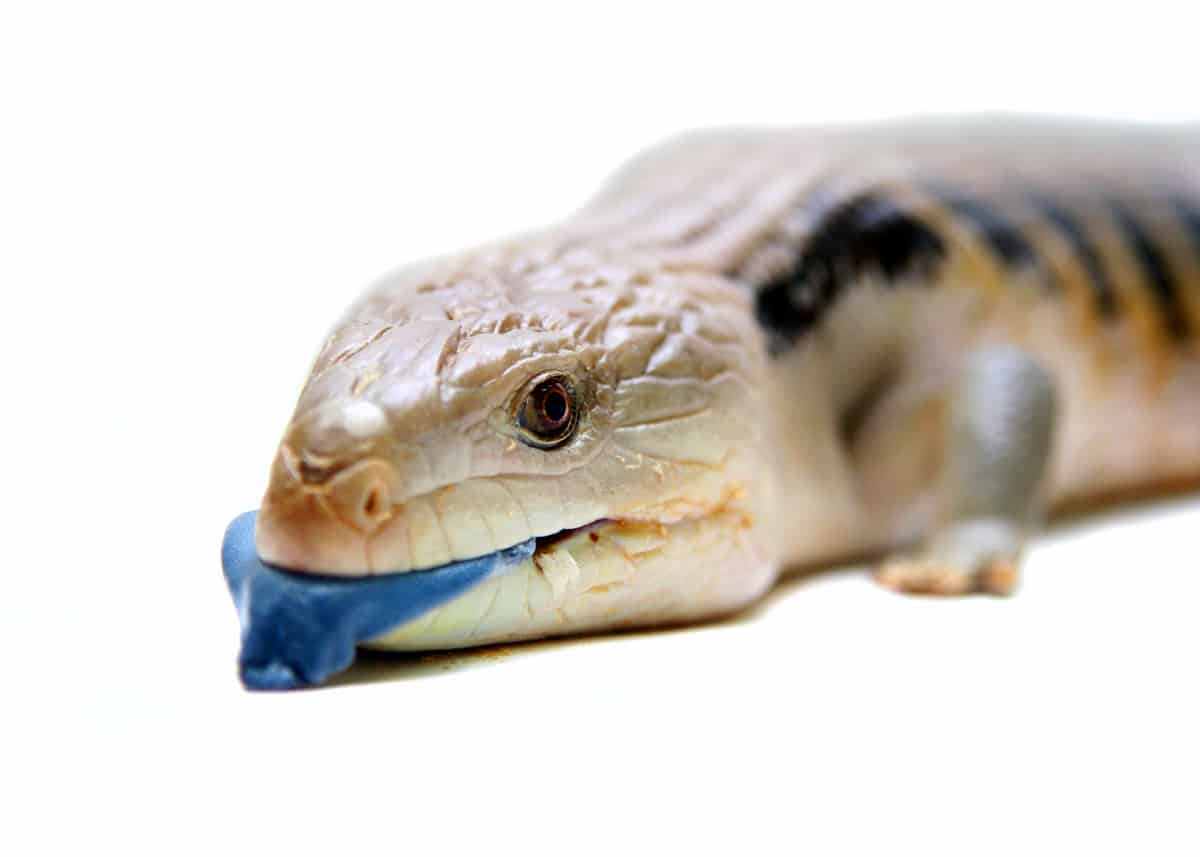
The Indonesian breed is known for their long tails; the shingleback is known for their short and stumpy ones. Here’s a full list of measurements:
- Adelaide pygmy blue-tongued skink – 9 – 15 centimeters
- Australian blue-tongued skink – 40 centimeters
- Blotched blue-tongued skink – 35 – 50 centimeters
- Centralian blue-tongued skink 30 – 45 centimeters
- Indonesian blue-tongued skink – 20 – 30 centimeters (body), 50 – 60 centimeters (total)
- Irian Jaya blue-tongued skink – 50 – 60 centimeters
- Shingleback – 25 – 30 centimeters
- Western blue-tongued skink – 40 – 45 centimeters
3. How much does a blue-tongued skink weigh?
There isn’t a lot of data on the weights of different blue-tongued skinks. Things like body length and tail size are considered more important. However, their typical range is around 10 – 20 ounces.
4. What is the blue-tongued skinks Latin name?
Each blue-tongued skink has its own scientific name.
- Adelaide pygmy blue-tongued skink – Tiliqua adelaidensis
- Australian blue-tongued skink – Tiliqua scincoides
- Blotched blue-tongued skink – Tiliqua nigrolutea
- Centralian blue-tongued skink – Tiliqua multifasciata
- Indonesian blue-tongued skink – Tiliqua gigas
- Irian Jaya blue-tongued skink – Tiliqua sp.
- Shingleback – Tiliqua rugosa
- Western blue-tongued skink – Tiliqua occipitalis
There are also sub-breeds for several of the species.
5. What other names does the blue-tongued skink have?
The blue-tongued skink has a variety of names and nicknames. In fact, let’s list them in full:
- Adelaide pygmy blue-tongued skink – pygmy bluetongue
- Australian blue-tongued skink – common bluetongue, eastern blue-tongued skink (Tiliqua scincoides scincoides), northern blue-tongued skink (Tiliqua scincoides intermedia), Tanimbar blue-tongued skink (Tiliqua scincoides chimaera)
- Blotched blue-tongued skink – southern blue-tongued skink
- Indonesian blue-tongued skink – Kei island blue-tongued skink (Tiliqua gigas keyensis), Merauke blue-tongued skink (Tiliqua gigas evanescens)
- Shingleback – bobtail, bogeye, two-headed skink, stump-tailed skink, pinecone lizard, western shingleback (Tiliqua rugosa rugosa), eastern shingleback (Tiliqua rugosa asper), Rottnest Island bobtail or the Rottnest Island shingleback (Tiliqua rugosa konowi), northern bobtail or Shark Bay shingleback (Tiliqua rugosa palarra)
6. Why do blue-tongued skinks have blue tongues?
It’s one of their most distinctive features, but why do blue-tongued skinks look like they’ve been sucking on a wild berry lollipop? The answer is “survival.”
Blue tongues are a rare sight in the wild, and they can both daze and scare off predators that are threatened by the unknown.
Some studies suggest that the blue pigment might also have ultraviolet properties that reflect light and create an even bigger danger signal.
7. Are blue-tongued skinks friendly or aggressive?
Blue-tongued skinks are gentle, slow-moving creatures. They make popular pets since they don’t mind being handled and will easily get along with others of their kind.
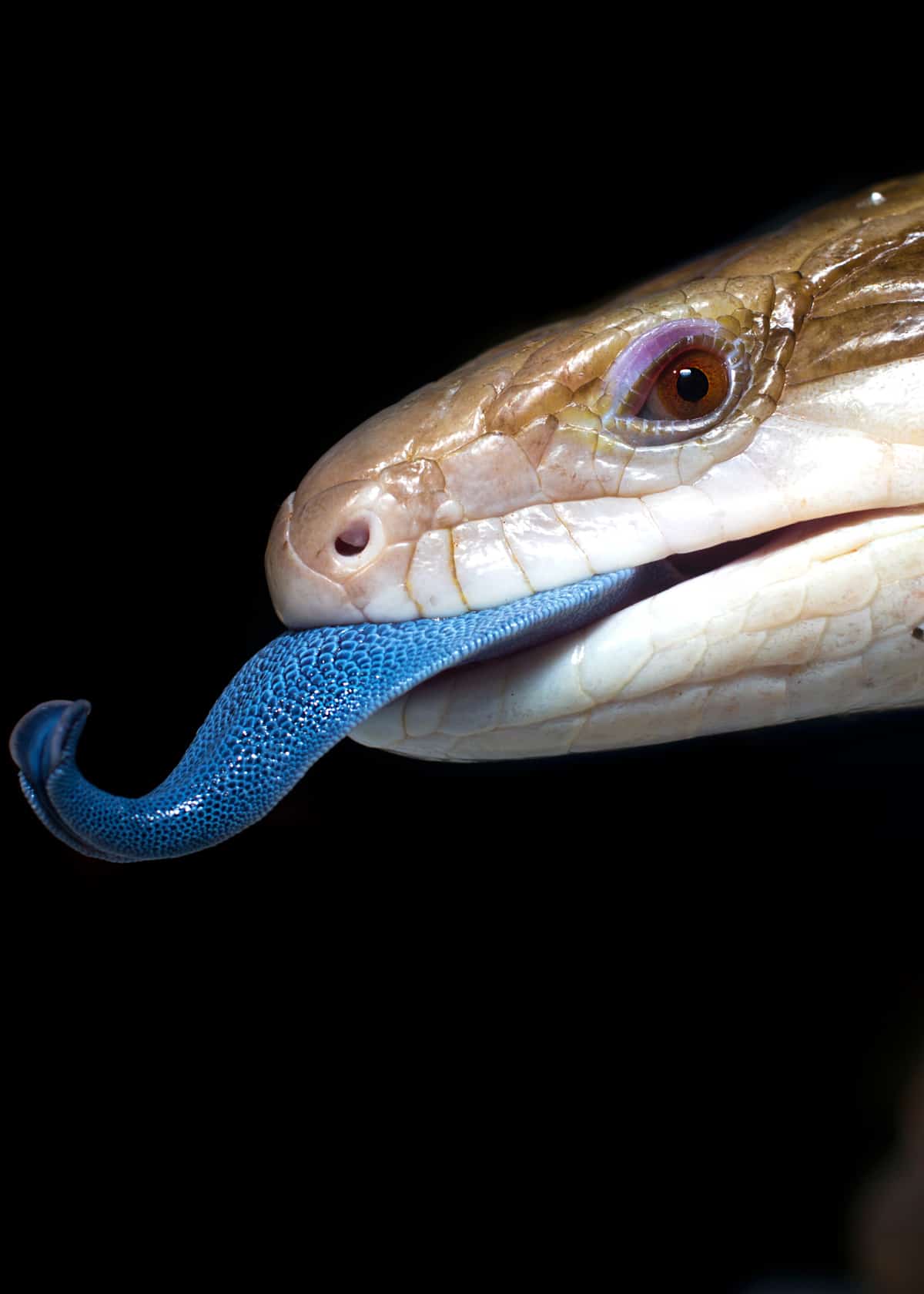
Males can become aggressive towards females during the breeding season.
And they’ve been known to bite when they feel threatened, but those are the only real concerns with them.
8. Do blue-tongued skinks bite?
Yes. While their bites don’t always have enough force to break the skin, blue-tongued skinks are in possession of strong teeth, and they’ll clamp down when they feel threatened.
It can be quite painful. You won’t need a visit to the hospital, but you’ll probably want some ice.
9. How long do blue-tongued skinks live?
Blue-tongued skinks have long lives. While their exact lifespan will depend on their species, it’s usually a good 30 – 50 years.
10. What eats a blue-tongued skink? Predators and Threats
As relatively small lizards, blue-tongued skinks are vulnerable to many different predators. They can be killed by snakes, weasels, dingoes, foxes, cats, dogs and even birds of prey.
They’re particularly vulnerable when they’re young; many juvenile bluetongues don’t survive past their first year.
11. Is the blue-tongued skink endangered?
Blue-tongued skinks are generally considered to be a vulnerable species. While the IUCN lists common blue-tongues as least concern, the pygmy bluetongues are endangered.
Native Australian organizations have different breeds classified as “vulnerable,” “near-vulnerable” and “at risk.”
12. Do blue-tongued skinks mate for life?
It isn’t known whether blue-tongued skinks mate for life, but it’s common for them to form monogamous breeding pairs that return to each other year after year.
Scientists have observed some pairs coming back together for up to 20 years!
13. How do blue-tongued skinks reproduce?
Mammals have live babies. Amphibians have eggs. Blue-tongued skinks split the difference: they’re viviparous, meaning that females grow and hatch their eggs inside of their bodies before giving birth to live young.

They usually deliver about 5 – 15 babies at a time.
14. What do blue-tongued skinks eat?
Blue-tongued skinks are omnivores that will happily munch on everything from flowers to insects.
Their hard teeth allow them to crunch open the exoskeletons of beetles and snails. Their long tongues let them lap up the juices and seeds from fruits, berries, plants, and weeds.
They’ll feed on carrion and dung when it’s available. In captivity, they’ve been known to enjoy sausage and chicken.
15. Are blue-tongued skinks poisonous or venomous?
No. You might be conditioned to think of brightly-colored tongues as poisonous ones.
But, there’s nothing about these skinks that makes them poisonous or venomous.
16. Can blue-tongued skinks amputate their own tails?
Yes. It’s called autotomy, and many lizards can do it. When they get caught by a predator or are roughly handled by a human, they can “drop” their tails right off and scurry away to freedom.
Only shinglebacks lack this ability among blue-tongued skinks; since they store their winter fat deposits in their tails, they don’t want to lose them.
17. Where does the blue-tongued skink live?
The blue-tongued skin is native to Australia, Indonesia, Tasmania, and New Guinea, but it’s sold as a pet all around the world.
Some species have a broad range, including the common blue-tongue; they’re found in multiple countries. Other species like Tiliqua rugosa konowi are more contained.
They’re only found on a small portion of Rottnest Island, Australia.
18. What is the habitat of the blue-tongued skink?
As small lizards that are vulnerable to many different predators, blue-tongued skinks like dark, secluded habitats.
Even when they’re making their homes in a grassy field, they’ll find a burrow or leaf pile where they can take shelter from threats.
Here’s a full list of their preferred habitats:
- Adelaide pygmy blue-tongued skink – These bluetongues live exclusively in old spider burrows. It’s one of the reasons why their numbers diminished until they were thought to be extinct; a lot of Australian land was cleared for agriculture, so both spiders and bluetongues lost their natural habitat.
- Australian blue-tongued skink – Australian bluetongues are some of the bravest bluetongues. They aren’t afraid to venture into residential areas and burrow around parks, gardens, backyards, and patios.
- Blotched blue-tongued skink – Blotched bluetongues are found in wet and dry regions alike. They mostly live in fields and forests, but they don’t mind mountains and coastlines. As long as there’s coverage from predators, they’ll be happy.
- Centralian blue-tongued skink – Centralian bluetongues aren’t very picky about their environments. They like grass, stone, and sand, and they can flourish in both arid and semi-arid habitats.
- Indonesian blue-tongued skink – Indonesian bluetongues are found in rainforests. They like the dense vegetation and high humidity.
- Irian Jaya blue-tongued skink – It isn’t known where these secretive bluetongues like to live. They’re a mystery!
- Shingleback – Shinglebacks have a wide range, so their habitats can be everything from sandy dunes to forested hills. They like to sunbathe, so they’re commonly spotted in fields or on roadsides. They’re relatively mobile and can travel up to 500 meters per day.
- Western blue-tongued skink – These lizards like grasslands and woodlands. They’ll often move into rabbit burrows after the rabbits have abandoned them. They’ll also hide under leaves and rocks when they sleep.
19. Can I pick up a blue-tongued skink?
You shouldn’t pick up a wild lizard, and this includes blue-tongues; you never know when they’ll lash out.
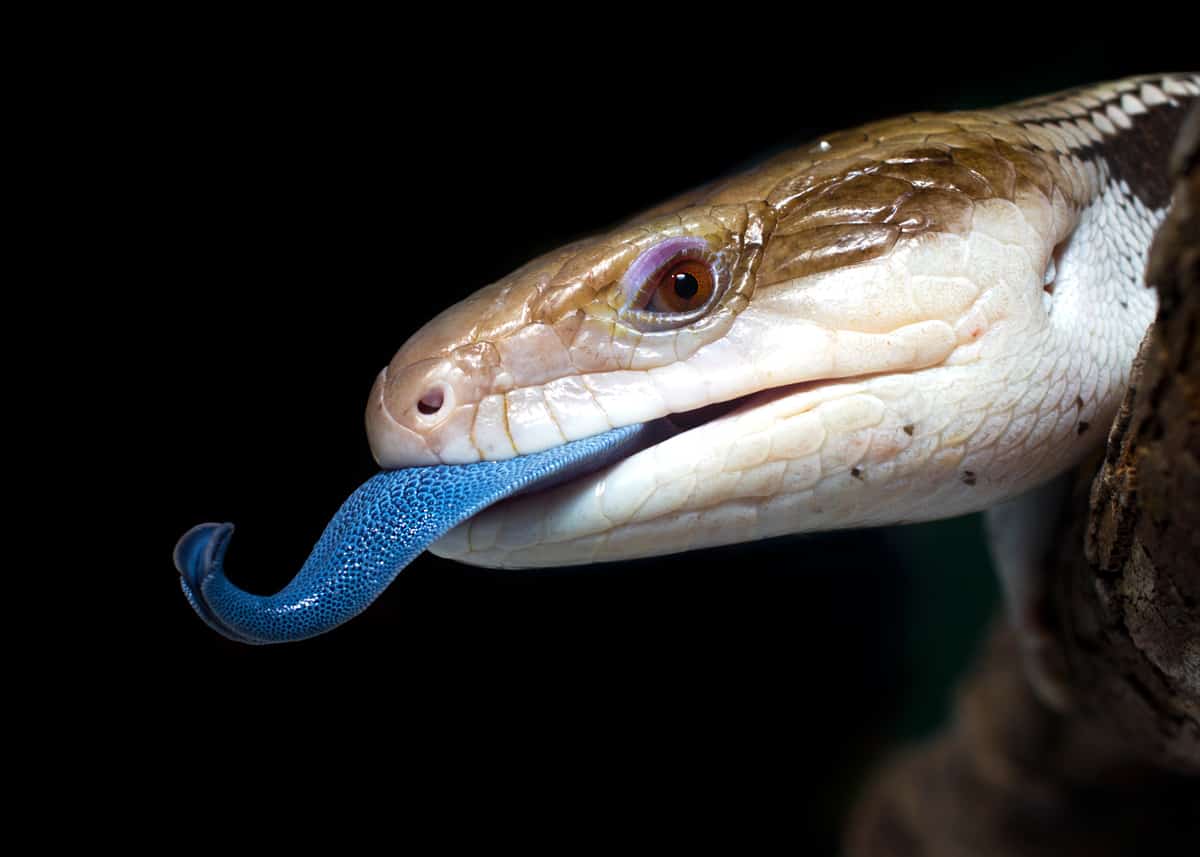
If you’re at a pet store, however, it’s probably safe to touch a blue-tongue. They’re used to being held, handled and transported between tanks.
20. Do blue-tongued skinks make good pets?
Blue-tongued skinks make great pets! In fact, they’re a pretty popular lizard species.
Their rarity makes them special, and their slow, gentle disposition makes them safe for kids. Additionally, their long lifespans mean that they’ll be with you for a long, long time.
21. Where can I see the blue-tongued skink?
Blue-tongued skinks can be found all around the world in zoos, museums, wildlife shelters, and exotic pet stores.
You shouldn’t have any trouble locating or adopting one, especially now that you’re armed with these blue-tongued skink facts!
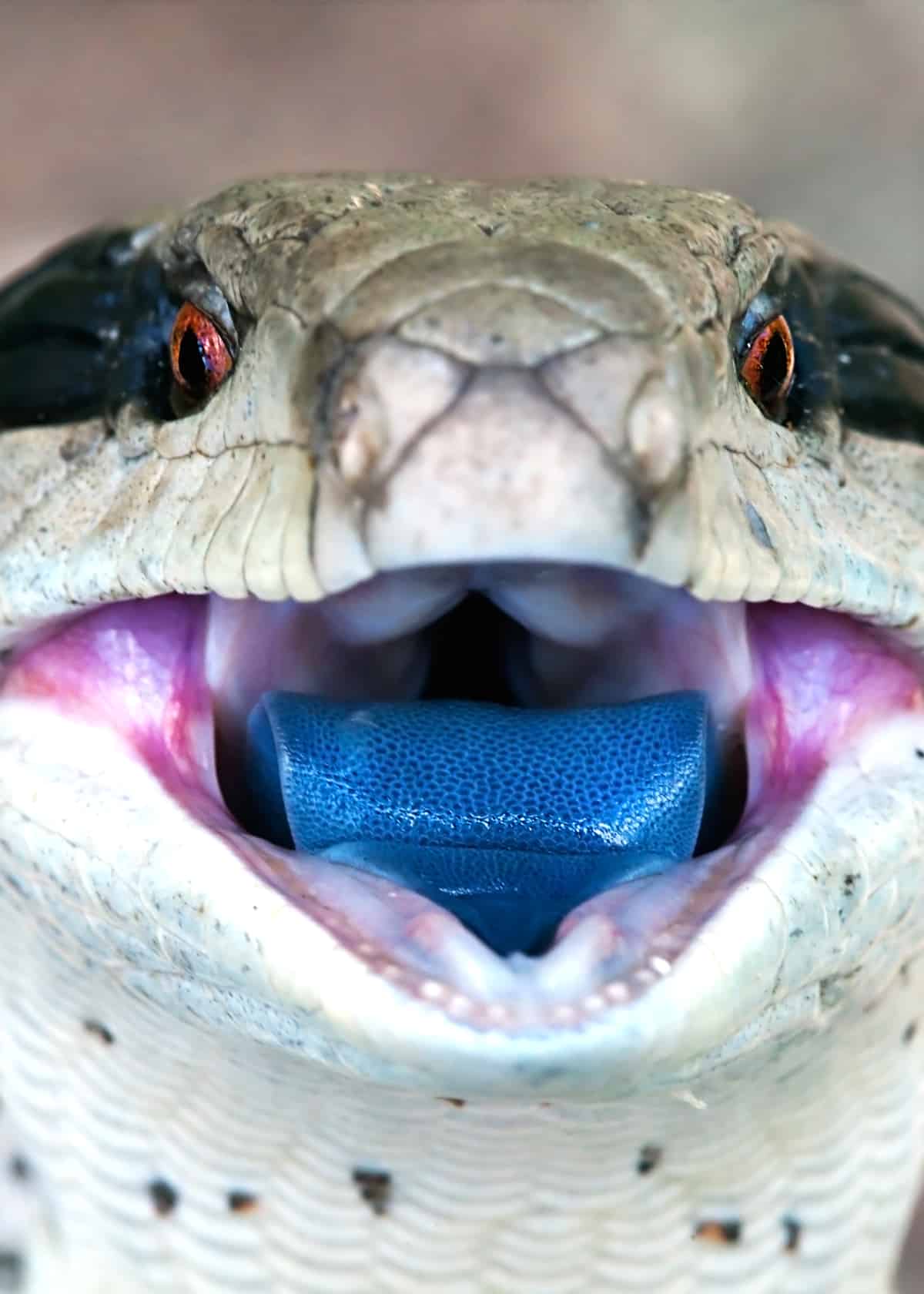
A Bolt From the Blue
What have you learned about blue-tongued skinks? Do you still have questions? Let me know in the comments!
Drew Haines is an animal enthusiast and travel writer. She loves to share her passion through her writing.
She graduated high school at sixteen and started her own business, Everywhere Wild Media. And she runs Everywhere Wild and JustBirding. She also guest blogs on Storyteller.Travel
She lived in Ecuador for 6 years and explored the Galapagos Islands. Currently based in N.S., Canada.

Paula
Friday 2nd of October 2020
Only when they poo.
Anne
Wednesday 11th of March 2020
I live in Ballarat Victoria Australia....have had a large blue tongue around for years but hardly see him..do they shed their skin as I found one in the back small shed along with a very large pile of snail shells ...is it ok to leave water and food out on the rare occasion that I see him as it's nice to know he is around ...Only seen him about 5 times over 8 years..
Paula
Friday 2nd of October 2020
Yes Blue Tongue Skinks shed their skin, it's how they grow wider. Once they reach adult age they don't grow any longer, but with each shed ( how often they eat determines how often they shed), their bodies grow wider. They Brumate (sleep) through winter and breed through spring, so leaving water out in spring and summer is perfectly fine. Owner of a Blue Tongue Skink.
Janice Concagh
Wednesday 4th of December 2019
Hi I live on Long Island in NY. I am interested in purchasing a Blue Tongue Skink for my son. Which breed do think is best for a child. We saw a Baby Indonesian at a Jungle Bob's for $300. That seems so expensive! He loved its coloring and the baby seemed friendly. I just want to purchase a friendly life long pet for him. Is there a breeder you recommend?Please help!! Thanks, Janice
Catfish
Tuesday 3rd of March 2020
$300 is high but blue tongue skink are not cheap. If it's a healthy captive born lizard. Then $300 is about right price from a pet shop. They are great pets!
Drew Haines
Monday 9th of December 2019
Hi Janice! Unfortunately, I'm really not experienced with owning skinks and I don't know any skink breeders. They seem like very docile reptiles and they don't mind being held. If you look on YouTube for blue tongue skink care, you should be able to find some good suggestions. Sorry I couldn't be of more help!
Olivia
Monday 11th of November 2019
Do blue tongue skinks stink?
Drew Haines
Wednesday 13th of November 2019
Hi Olivia, that would certainly be funny! But no, the only thing that stinks about skinks is there poo. So as long as the cage is clean, you shouldn't have any problems! Thanks for your comment 😊